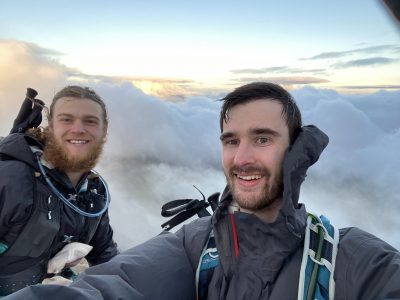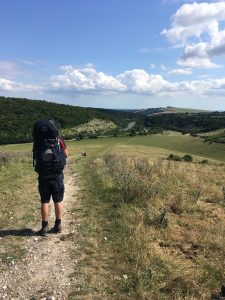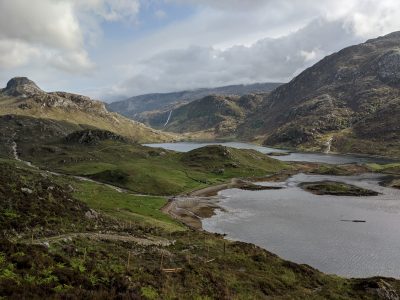No plan Norway: Shackleton, unshackled

In June, Zoë and I took a relatively spontaneous trip to Norway for some hiking. We booked the flights and both said we would think about what we would actually do in the couple of weeks before we left, and neither of us did. As a last resort, the day before flying, I stuffed an old copy of NUBES into my bag with the intention of using it as a guide to follow in the footsteps of the 2013 Norway summer trip. This was my first serious backpacking trip since breaking my back and feet in 2016 and I was both curious and slightly nervous to see how I would cope with carrying a 20kg rucksack for several days.
On the journey out I began reading South: The Endurance Expedition by Ernest Shackleton, an account of the last of the great journeys in the age of heroic polar exploration that spanned the end of the 19th and beginning of the 20th centuries. I had bought the book for my dad for Christmas, essentially so that I could read it myself. I quickly found a coincidental connection to our trip as the expedition’s specialised ship Endurance was built in Sandefjord, whose airport we were flying into and where Ryanair thinks Oslo is. Shackleton’s expedition set off South in 1914, with the intention of being the first party to cross the Antarctic continent from the Weddell Sea to the Ross Sea via the South Pole, while other members conducted scientific and geographical research. Things did not go to plan, and what followed must be one of the greatest stories of survival of all time.
Due to Zoë’s unusual habit of living in the North, she was on a later flight than me so I had a long wait in the airport to make headway with the book. Shackleton did not manage to get all the way through the pack ice to make a landing on the continent in the summer of 1914/15 (summer being in our northern hemisphere’s winter months) and the Endurance was frozen in for the winter (winter being in our northern hemisphere’s summer months). This was not an unanticipated occurrence and despite the long darkness they seemed to have a jolly good time training their dog teams, having sledge races and the odd game of football on the ice. That all ended when, just as the new summer was coming in, the pressures and motions of the sea ice caused it to close around and finally crush their ship, leaving twenty-eight men and fifty-odd dogs stranded on unnavigable sea-ice, with no way of contacting the wider world. There was nothing to be done but salvage all they could from the Endurance’s semi-submerged carcass, find a relatively stable ice floe, build a camp, and settle in to wait. Shackleton believed that the ice in the Weddell Sea gradually drifted clockwise, essentially in an enormous eddy off the Southern Ocean, and that if they held out for long enough they would eventually drift north where the pack was loose enough to launch their three small ship’s boats.
Zoë’s flight came in late and our easiest option for the night was to wild camp hidden behind a few trees next to a multi-storey car park. In the morning we got a train to Oslo and went into the Norwegian Trekking Association (DNT) shop, where we were assisted in planning a route. Because Norway is amazing, it was very difficult to choose, but in the end we decided on a walk across the Hardangervidda national park to the landmark of Trolltunga. We then met up with ex-Erasmus UBESter Karoline for a tour of Oslo including government buildings, the royal palace, and many nude statues.
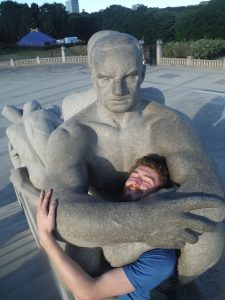
Look at those arms. You’d feel so safe with them around you
An overnight train journey deposited us at Haugastøl, a tiny town on the way to Bergen, at four in the morning, light but cold. We pitched the tent and got a few hours’ sleep on a peninsula in a lake, then had our first ice-cold wash in its clear waters. While waiting for a bus to take us an hour down the road to the start of our walk we started speculatively sticking our thumb out and in five minutes had hitched a lift instead.
Hardangervidda is a vast mountain plateau lying above the treeline. Its wide expanses and Arctic flora and fauna (including reindeer) give much of it a tundra-like appearance. We started walking at 2pm and after a few hours were wondering what we had signed up for. We felt like tiny specks in a bleak and endless wilderness of majesty and monotony. We hoped it wouldn’t all be the same. There was a moment of excitement and human drama when we angered a pair of skuas, presumably by unwittingly wandering too close to their nest. We waved our poles in the air to try to ward them off as they dived at us again and again, growing bolder each time. After covering 20km we found ourselves by a lake and decided to get the tent up before we were eaten by mosquitos. I was very relieved to find that though I was sore from my bag’s straps I didn’t seem to have wrecked my back and after a night’s rest would be able to carry on. Having thought myself crippled for nearly two years, this was wonderful.
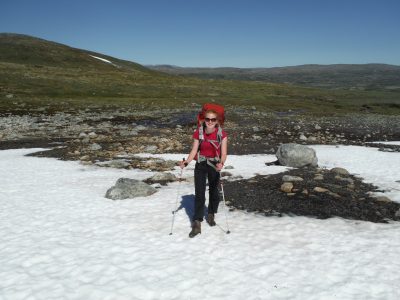
Crossing the plateau
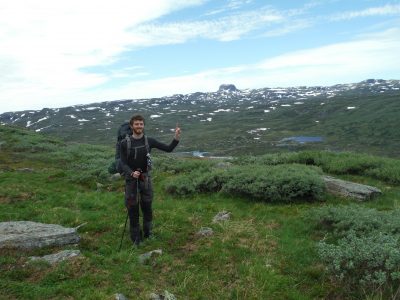
Look at that weird mountain
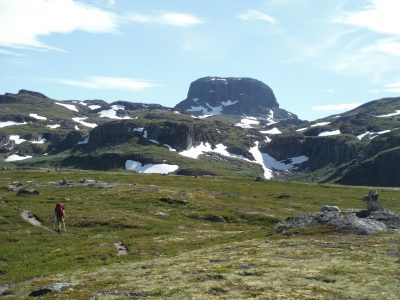
Getting closer to the weird mountain
The next day our fears of monotony soon were quelled. From our lake we followed the water course downwards until a valley opened up in front of us. We rounded a hillside and stood on a shoulder where we could see huts down in the valley and in the distance far beyond the other side, a strangely shaped mountain. It was Hårteigen, with vertical walls rising up like a cylindrical fortress overlooking all the land around. Down at Hadlaskard we discovered that the comfortable and beautifully furnished hut was entirely self-service and operated on a trust basis. It would be nice to imagine this system would work in England, but we sadly reflected that it almost certainly wouldn’t. We made our way up towards the mountain. The upthrusting rocky formation is almost circular but with a gully in one side which you can ascend with the aid of fixed ropes. The weather was glorious the whole week and the view from the top stretched out unimpeded. To the West a mosaic of snow patches adorned rolling mountaintops, while to the East was the tundra-like plain going on to the edge of sight. We had a photoshoot then returned down to camp on a mossy hillside with the evening light turning Hårteigen as golden brown as the flapjacks I had attempted to make for the trip. Sore once again from the day’s exertions, I returned to my book.
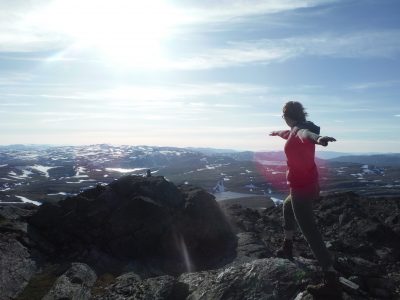
Kriger to
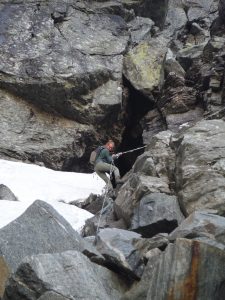
Descending the gully
The expedition spent over five months living on the ice. Seal meat made up the bulk of their diet and the blubber provided fuel for their improvised stove. After a couple of months the ice under their first camp began to break up and they attempted a march North. Each day of this involved multiple trips back and forth and much hard labour to drag the boats over pressure ridges and slushy ice. After covering only a few miles, Shackleton could see that the men were becoming exhausted, so they built a new camp – “Patience Camp” – on a more stable piece of ice and continued to wait. Their excellent navigator Worsley kept track of their position with a sextant. Southerly winds were a blessing that pushed them gradually northwards. Northerly winds were to be cursed. After more than three months, the pack ice began to open up and eventually it became possible for the boats to be launched. The last of the dogs were shot and supplies were loaded. They had to navigate the opening and closing lanes of water through the floes. Damage to the boats was both likely and potentially disastrous. There was never a guarantee of finding safe ice to camp on, nor that the water would be open in the morning. All the time rations dwindled and clothes never fully dried. At last they left the body of the ice pack behind and attempted to cross the open water in the hope of landing on an island. Water ran out and they sucked ice, though it blistered their tongues. When they made it to the shores of Elephant Island they had to brave the tides and breakers that threatened to dash them upon the very land they longed for. Miraculously, all hands got ashore – the first people ever to land there – and they felt rock beneath them for the first time in a year and a half. However, their new camp was on a narrow spit exposed to the fury of the Southern Ocean. Cliffs and glaciers blocked any attempt to move inland. And still nobody knew of their plight. A journey for help would have to be attempted.
Zoë and I began the next day feeling good. We had realised that there was a shorter route to Trolltunga that we hadn’t initially known about that cut out about ten hours’ walking time. Also I think it is often the case that the first day or two of a trek are the hardest, before your body gets used to the idea. We took time to enjoy skimming stones on a glass-clear lake (“crystal-clear” doesn’t do this water justice), sing songs, and giggle at the name of the area we were moving through – Grotbotnen. Each day of the trek had involved at least one river-fording and today’s was the freezingest of the lot. When we stopped for lunch we were overtaken by some Germans whom we then overtook back and felt obliged to stay ahead of, through awkwardness rather than competition. We began to cross more and more snowfields, which made me increasingly uneasy after Luise’s misadventure on the Iceland trip a few years ago. After a leisurely 17km we made camp on a sunny hillside over another clear lake semi-covered in floating ice. We then had down time for some dodgy sewing and more reading.
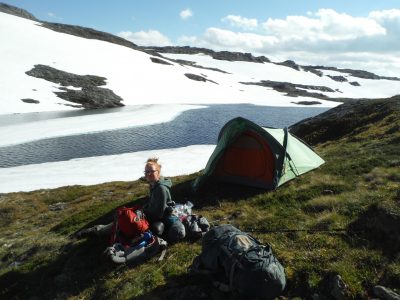
Campsite with bath
Shackleton chose the navigator Worsley, the slightly older but resourceful carpenter and three of the healthiest men for the voyage. Their goal was to land and make contact with the whaling stations on South Georgia, 800 miles away. For two weeks they were tossed about like a toy on the freezing waves, cramped under an improvised and not watertight covering. When they sighted land they were well on their way to dying of thirst, cold and exhaustion all at once. Even when they were so close, it was another two days before they could find a spot to land. They found a cave to sleep in and albatross chicks to eat and at last had a chance to recover their strength. They would need it – the whaling station was on the other side of the island. Putting out to sea again would be too dangerous and the interior of the island was a labyrinth of steep mountains and glaciers that had never been traversed even by a fit and well-equipped party. Three of the six were too weak to attempt it. For mountaineering equipment they had fifty feet of rope and a carpenter’s adze as an ice axe. The carpenter took screws from the boat and put them through Shackleton’s boots for grip.
Zoë and I had it a bit easier (like pretty much everyone else ever). We had covered more ground than we expected and basically had a bimble over the gently sloping mountaintops to Trolltunga. The fine weather continued – in fact we didn’t see a cloud all day – and everywhere the snow was melting into gorgeous glittering pools and tripping down the mountain via glorious waterfalls. We tried to stay on rock as much as possible for fear of the snow collapsing beneath us. We arrived at Trolltunga and immediately felt weird about being surrounded by people after days alone. Trolltunga is a flat rock jutting out over a fjord where dozens of people come every day to get a cool profile picture. The view was beautiful, but we almost wished we had stayed back in our private mountains a bit longer. Some guy was obnoxious enough to start trying to play a whistle on the rock, and he wasn’t even any good. I was really in the grip of the story now, so I eschewed the potential for people-watching to carry on.
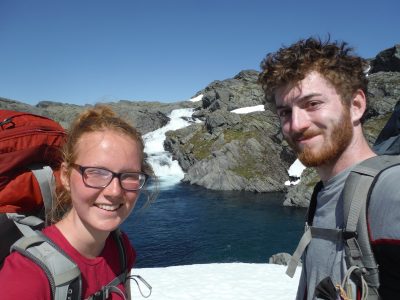
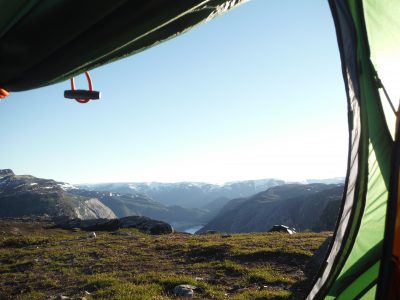
Evening view, Trolltunga
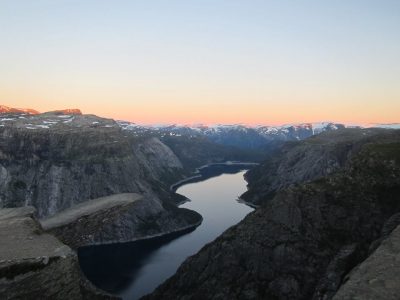
Trolltunga
Shackleton, Frank Worsley and Tom Crean set off by the light of the full moon in the early hours of May 19th, 1916. They took three days’ rations and no sleeping bags. The land was uncharted and they had to trust their luck that they would find a way. They marched and climbed for 36 hours without rest. They climbed an icy ridge three times before deciding the only way down the other side was to slide into the unknown. They cut steps in blue ice with the adze. Upon reaching the whaling station, the first people they encountered ran away from them in fright. Finally they met the Norwegian manager of the station who provided them with all they could possibly want. Worsley went with a whaling crew the next day to retrieve the three they had left on the other side of the island, who did not recognise him washed, shaven and dressed in clothes different to the ones he had been wearing for months. The men confessed to each other that they had all felt the presence of a fourth man with them on the march, of providence guiding them.
For the twenty-two men left on Elephant Island, hard times were far from over. Despite Shackleton bending all his will and energy on rescuing them, it would be another three months before a vessel got through the pack ice that frequently surrounded the island. It took four attempts and prodigious help from the whalers and the Uruguayan and Chilean governments, and the final attempt only succeeded through the good fortune that it coincided with the pack clearing for a few days. The men on the island had two days’ food left, but were packed and ready to board, as they had been every day the sea was clear since a couple of weeks after Shackleton’s departure. Not one of them was lost.
That was the 30th of August 1916. The men were overwhelmed to hear what had happened to the world while they had been gone. The war meant the end of the age of heroes as all the brave few explorers’ valiant exploits paled in comparison to the sacrifices an entire generation made on the battlefield. After being released from Antarctica’s icy grip after two years, most of the men enlisted for active service as soon as they could.
I woke up in the early morning and took some pictures of Trolltunga in a precious moment when nobody was around. Sadly, by the time both of us properly got up, there was already a queue of people posing, so we never actually got our own chance. As we went down we must have passed at least two hundred people making the long ascent up the fjord. Down in the valley we had a rudimentary wash in a lake before starting to try to hitch a lift. We got one to the nearby town of Odda where there was a bus station but decided we could keep trying to hitchhike for a while before giving up and getting on a bus. However, we failed to actually check the bus times and soon found that there were none that would get us back to the airport in time. We thought the hard part was behind us but suddenly we were in a pickle.
After what must have been at least an hour and a half, someone stopped for us. She was only going to the edge of town but it might help. After hearing our plight she took pity on us, drove us to the junction with the main road, and produced a list of towns on the way to Oslo that she seemed to have ready-written for us. Where she dropped us there was nowhere for cars to stop so we had to walk through a pavement-less tunnel in search of a lay-by. It was a blessedly short wait before we were picked up by our next saviour, a Polish mountaineer and wingsuit-pilot who took us more than an hour in the right direction. The drive, incidentally, was stunning the whole way.
It was getting late (though not dark) when he dropped us off at Haukeli to drive on to Poland. What little traffic there had been had dried up almost completely, down to a single car every few minutes. If we could just get to the next town on our list (admittedly over two hours away) then there would be buses we could catch. I began to append my thumb gesture with praying hands. Finally, at the end of hope, our last and greatest angel of the road arrived. His name was Nils and he was coming home from a fishing trip. Through a combination of his slightly halting English and my utterly-refusing-to-budge Norwegian we explained the situation. Nils lived in a village to the South but would be driving in to work the following morning in a town from which there were express buses to Sandefjord airport. We could put our tent in his garden and he would drive us there in the morning. He would just ring his “very nice” wife Ingrid to tell her.
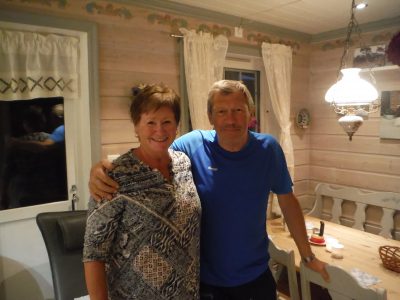
Nils and Ingrid
We arrived at their gorgeous wooden house and were invited in to look around and meet their puppy. Ingrid said we could sleep in the garden if we wanted but there was a free bed for us, and we could have showers. We were overwhelmed by their kindness. While we showered Ingrid prepared some of the fish Nils had caught and we were invited to join them for a very late supper. When we finally got into our sleeping bags on that wonderfully comfy bed we reflected that it had been a strange day. We were treated to breakfast the following morning before being taken in to catch the bus and arrive at the airport with hours to spare.
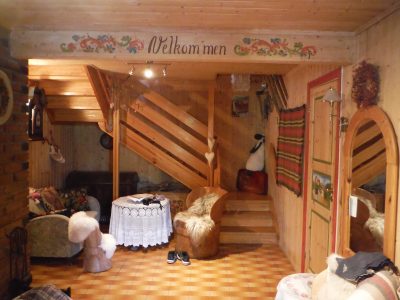
Surprise accommodation for our final night
We had had a fun adventure and I had reached what I felt was an important milestone on my road to recovery. I may still get an aching back and stiffness in my ankle but for the first time since falling down the gorge I can backpack again. I can climb and trek and camp and carry all my own gear without help. After 21 months, the shackles my injury clamped onto me, which for some time had me unable to leave a wheelchair or bed, and for even longer had me wondering if I could ever do what I loved again, were finally off.
Alasdair Robertson
I highly recommend Norway for a spontaneous adventure. We really did do almost no prior planning and only decided the route we were going to walk when we were already in Oslo. The DNT shop was extremely valuable for this. In addition to selling gas and camping supplies, they have planning tables and helpers on hand with up-to-date knowledge of conditions across the country. If transport links had worked out differently, we might have had to spend a night in a hostel in Oslo, but as it happened we didn’t have to pay for a single night’s accommodation.
Expedition cost breakdown (approximate, all in-country travel booked on the day of travel)
Return flights Stansted – Sandefjord: £150 (booked at short notice)
Train Sandefjord Airport – Oslo: £20
Train Oslo – Haugastøl: £50
Bus Skien – Sandefjord Airport: £10
Food for 1 week (bought in UK): £30
Gas and maps (bought in Norway): £30

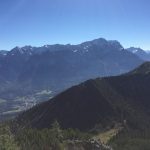 Previous Post
Previous Post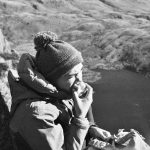 Next Post
Next Post
